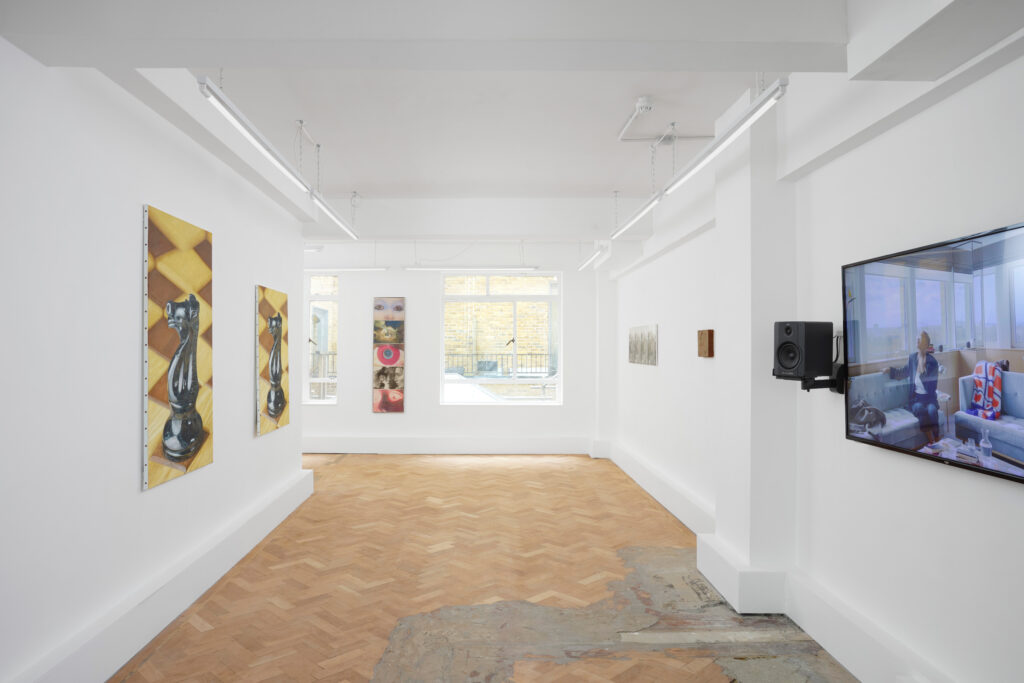



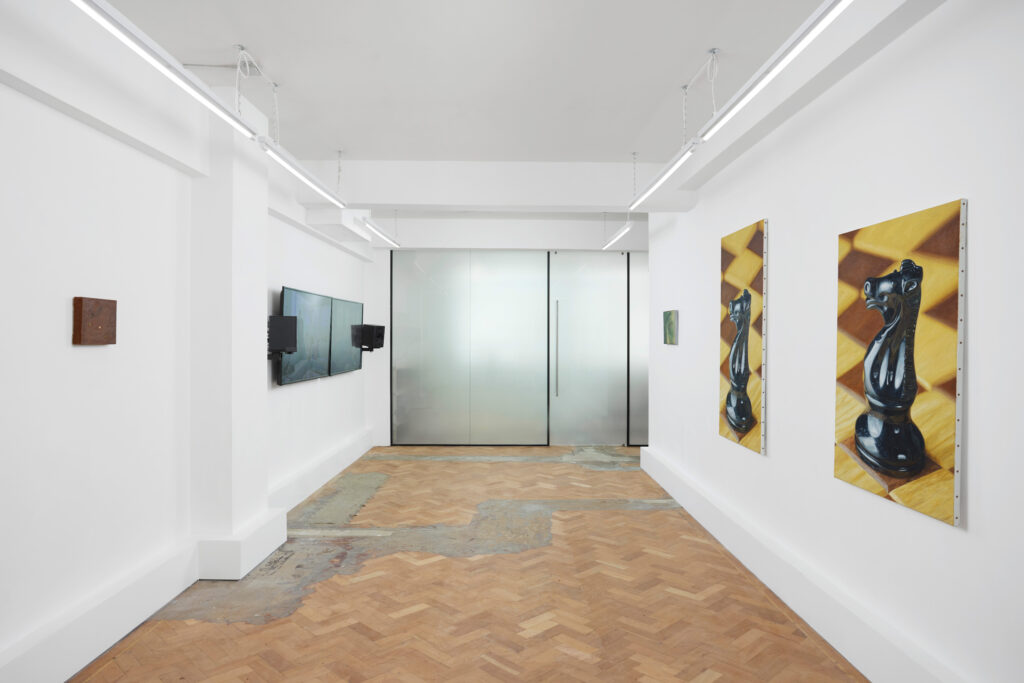

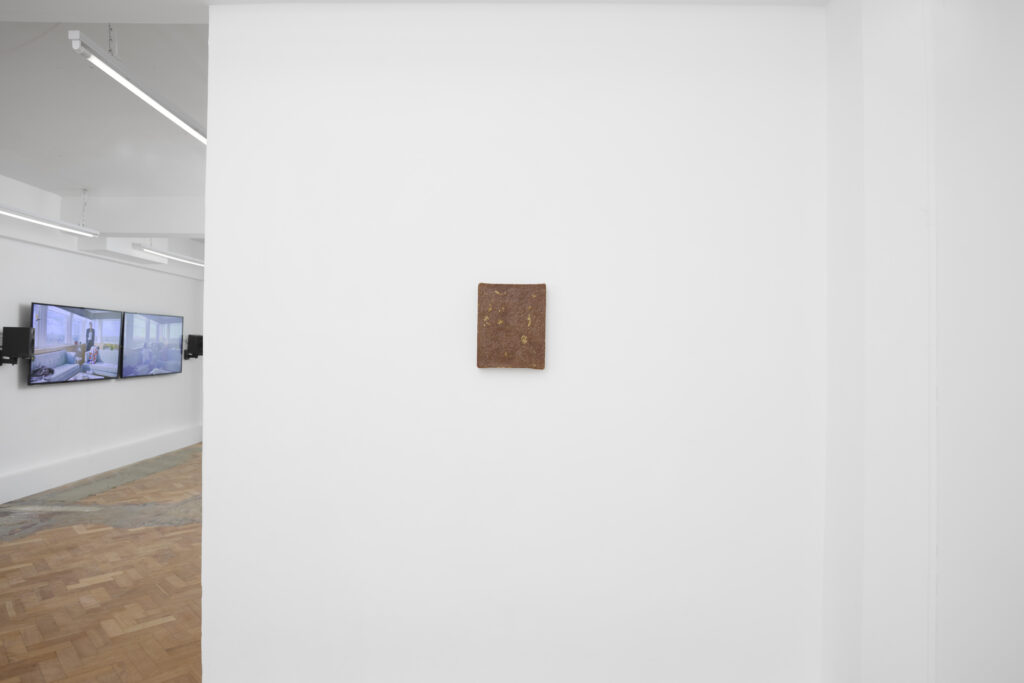
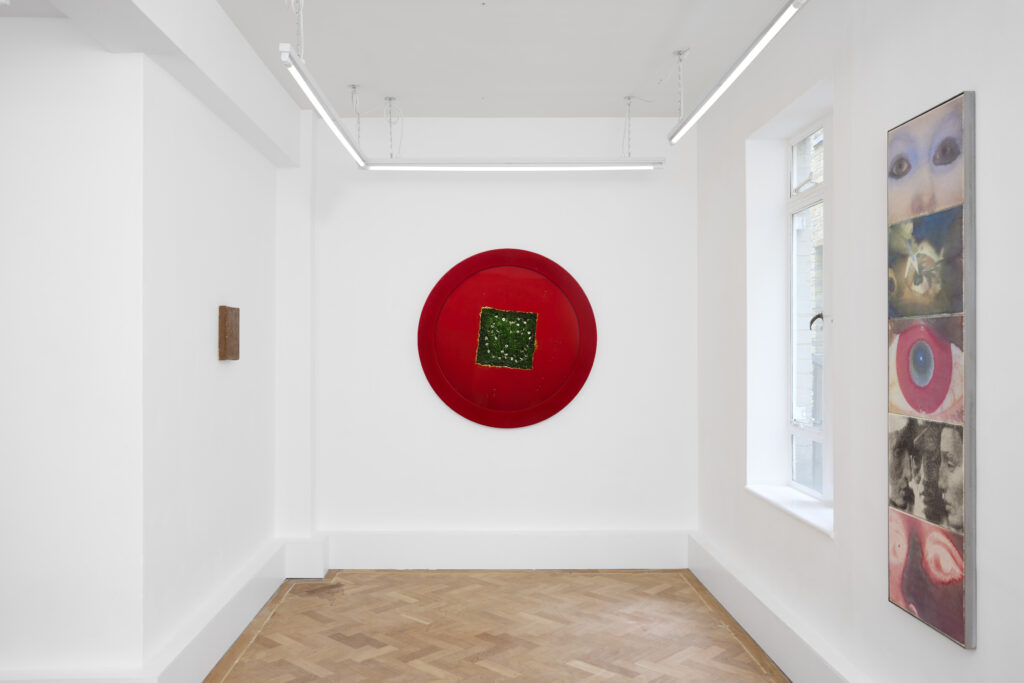




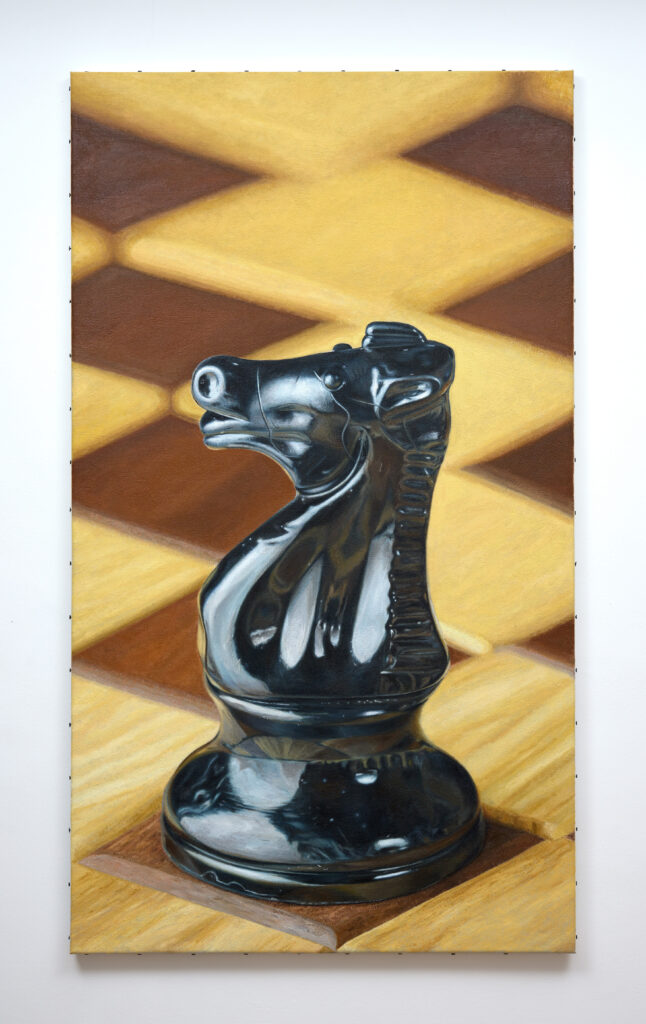



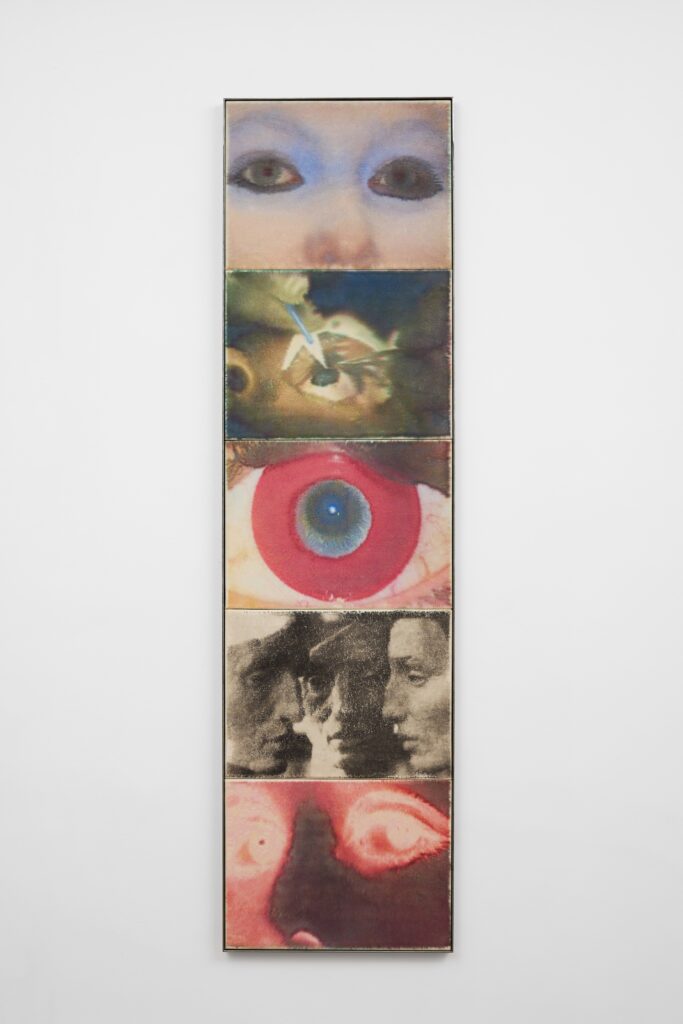
61×161/2×11/8inches
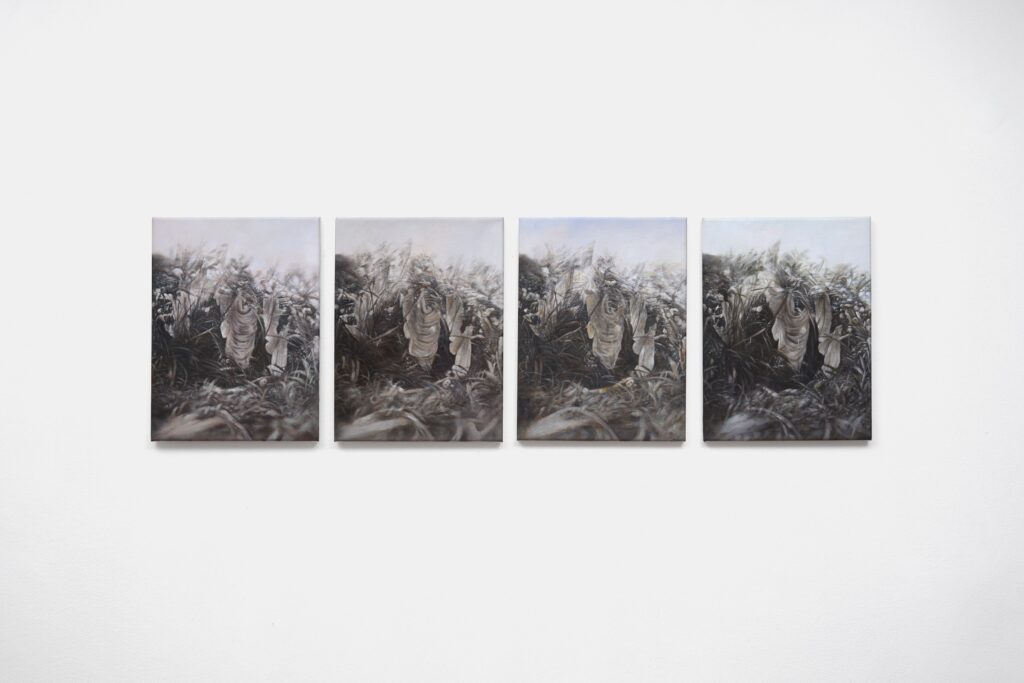

Arcadia Missa is excited to present Recital, the inaugural exhibition in our new 1st floor gallery space.
For this group exhibition, we are looking at the notion of performativity from the perspective of the artwork and the act that it fulfills. The “performativity” here is not defined by any strict set of aesthetic terms, but instead looks at the process of making the work in relation to the purpose it fulfills within the context of being shown in the gallery space, to an audience. At the forefront is the performativity of the artwork itself and its transformative capacity.
Upon entering the room, one is followed by Sang Woo’s You’re looking at me 003—we are looked back upon by the painting and our position as a viewer is marked as an active state, a consuming force. This act of viewership-as-surveillance, or our interaction with the work itself, become the terms on which we enter the exhibition.
In Alex Margo Arden’s works performativity is at the forefront of the subject matter, the four paintings depict one of the five photographs taken of The Cottingley Fairies. These were images taken by two cousins Elsie Wright (1901–1988) and Frances Griffiths (1907–1986), who claimed to have seen real fairies and photographed them. The image chosen by the artist to reproduce was the fifth and final photograph, which both claimed to have taken, and is likely a double exposure. When confessing the hoax, they were in disagreement about this photograph: Elsie said that it was a fake, while Frances insisted it was a genuine photograph of fairies. As much as a sense of performance is engraved in the visual of the paintings, it is the performance of labour that underpins these works. Each canvas is made by a different commercial painter instructed to copy the image. The outcomes become evidence of interpretation, and when collated together act as reinvestigation of the original photographs content.
As with Arden’s works, suddenly, Hamishi Farah’s hyper realistic figurative paintings seem abstract. Sven Lütticken writes about the return to formalism, he argues that “form should be thought of as the mediation-—and, at times, the conflict— between deep structure and concrete articulation. Form enacts a dialectic of the concrete and the abstract—an oscillation that makes it central to modern thought”. The abstraction in Farah’s work is not figurative but contextualized, the painting does not reflect upon itself and the context of the artist, but it abstracts the position of the viewer within the current cultural sphere of production.
Throughout the show there is a suggestion that the productional aura of the work isn’t dependent on the processes tied to the artist but the processes experienced by the viewer. Ultimately, we question whether any signifier can exist in singularity. In Edgar Calel’s works Runojel xa xti jotayimpe, Runojel xa xti tzolimpe, chuech ri ruach’ulew (Everything Will Blossom, Everything Will Reappear Before the Face of the Earth), which he and his family have done collectively, the static becomes active through what the artwork signifies and therefore what it performs within the context that it resides in. His canvases feature landscapes, objects, relics, concepts and experiences, that are only known to him and his family, but that are of spiritual importance to the Maya Kaqchikel people. The paintings are then covered almost entirely with clay collected from a sacred forest where they perform sacred rituals and offerings, and presented in the gallery space. They might decide to shed their clay and present themselves at some point, but this choice lies with the painting— with the knowledge embedded on each canvas hidden in plain sight under the earth, and only to be revealed when the moment is right and we are finally ready to experience it and take it in.
Helen Chadwick’s Wreath of Pleasure is from a series of photographs made over 1992-93, of flowers which have been precisely arranged in combination with poisonous or pleasurable liquids such as chocolate and Windolene. Flowers stuck between life and death. Chadwick changes the visual language around how we depict sexuality and bodily forms—subverting signifiers and playing with the theatricality of those which she uses. The processes captured in the photo are carried into each space they are exhibited.
Similar to Chadwick, Deborah-Joyce Holman plays with visual compositions and techniques to retain agency. Meditating on Black and queer subjecthood in visual culture, the work documents two performers reciting excerpts of Portrait of Jason by Shirley Clarke. The linear timeline of visual references has been reflected back to itself, displacing the viewer in a space defined by one’s own references interacting both with the community but also the individual.
Noting the agency contained in all these practices paves a way for the artworks to perform and opens up space for the present to unravel and reveal itself from a different angle, which can be rationalised if one wishes to do so. Essentially the one interacting with the performativity of the work is the one most exposed at a certain moment in time, the viewer.
Alex Margo Arden (b. 1994, Croydon, UK) is an artist who lives and works in London. She uses theatrical methodologies to interrogate the production, interpretation, restoration, and restaging of histories. Through her conceptual research projects she often employs remaking and reperformance to question authority, authenticity, and labour. Recent solo exhibitions include, ‘Attention Restoration’ (2023) at Quench, Margate; ‘Rock Paper Scissors’ (2023) at Royal Academy of Arts, London; ‘Responsibility, Responsibility Responsibility’ (2023) at Art-O-Rama, Marseille; ‘All Clear’ (2022) at Ginny on Frederick, London, THE FARMYARD IS NOT A VIOLENT PLACE…’ (2020) at Cell Project Space, London. Her work has been written about in Frieze, Art Monthly, The Art Newspaper, Flash Art, Another Magazine, and American Vogue. She is currently studying at the Royal Academy Schools and she previously graduated from Goldsmiths where she was awarded the Hamad Butt Memorial Prize.
Edgar Calel (b.1987, Chi Xot -San Juan Comalapa, GT) studied at the Escuela Nacional de Arte Rafael Rodrı́guez Padilla in Guatemala City. He works in a variety of media, exploring the complexities of the indigenous experience, as seen through the Mayan Kaqchikel cosmovision, spirituality, rituals, community practices, and beliefs, in juxtaposition with the systematic racism and exclusion that the indigenous people of Guatemala endure on a daily basis. In 2023 Calel had his first institutional solo show, B’alab’äj (Jaguar Stone) at SculptureCenter, New York and is a part of the permanent collections of Rijkscolectie- National Collection of the Netherlands; Hammer Museum, Los Angeles, USA; Tate, UK; among many more. He currently has a show in La Nueva Fábrica (LNF) in Guatemala.
Helen Chadwick (b.1953, Croydon, UK, d.1996, London, UK) was a British sculptor, photographer and installation artist. In 1987, she became one of the first women artists to be nominated for the Turner Prize. Chadwick was known for “challenging stereotypical perceptions of the body in elegant yet unconventional forms. Her work draws from a range of sources, from myths to science, grappling with a plethora of unconventional, visceral materials that included chocolate, lambs tongues and rotting vegetable matter. Her skilled use of traditional fabrication methods and sophisticated technologies transform these unusual materials into complex installations. Maureen Paley noted that “Helen was always talking about craftsmanship—a constant fount of information”. Binary oppositions was a strong theme in Chadwick’s work; seductive/repulsive, male/female, organic/man-made. Her combinations “emphasise yet simultaneously dissolve the contrasts between them”. Her gender representations forge a sense of ambiguity and a disquieting sexuality blurring the boundaries of ourselves as singular and stable beings.”
Hamishi Farah (b.1991, Melbourne, AU) is a self-taught artist currently living and working between Berlin and New York. Their work in conceptual and figurative painting is situated within the production of a politics and philosophy of representation, with a particular focus on the libidinal afterlife of coloniality and its permeation through contemporary art. Their recent solo exhibitions include Black Painting, Maxwell Graham / Essex Street, New York, US; London, UK, Arcadia Missa, London, UK (2023); Dog Heaven 2: How Sweet the Wound of Jesus Tastes, Fri-Art Kunsthalle, Fribourg, CH (2021); Antagoni, Chateau Shatto, Los Angeles, US (2020) and Condo London, Arcadia Missa, London, UK (2020) among others. Hamishi Farah’s work is part of National Gallery of Victoria, Melbourne (AU) public collection.
Deborah-Joyce Holman (b.1991, Basel, CH)
The practice of Deborah-Joyce Holman is concerned with the relationship between popular visual cultures and capital and the intertwined politics of representation. Holman contrasts the exploitative potential of how images collide with capital with approaches of artistic and cinematic subversion, repetition and refusal using differing approaches across media such as video, sculpture and painting. Their work has recently been shown at Kunsthalle Bern; Galerie Gregor Staiger; (both 2023); Cordova, Barcelona; Istituto Svizzero, Palermo; schwarzescafé, Luma Westbau, Zurich; Institute of Contemporary Arts, London (all 2022); 7th Athens Biennial; Cherish, Geneva; Yaby, Madrid; Centre d’Art Contemporain, Geneva (all 2021); La Quadriennale di Roma (2020); Mikro, Zurich; Fondation Entreprise Ricard, Paris; Auto Italia, London (all 2019), among others.
Sang Woo Kim (b.1994, Seoul, KOR) Born in South Korea and moving to the UK at a very young age, Sang Woo Kim’s discourse addresses his fractured identity and confronts the alienating cultural factors that affected him early on. Throughout his life, he grappled with a sense of otherness, shaped by the clash between his traditional Korean upbringing and the Western culture surrounding him. This profound sense of displacement permeates Kim’s works, serving as a central theme in his artistic discourse. Through a poetic visual language rich in metaphors and analogies, Kim confronts the complexities of identity, primarily focusing on the challenges of navigating cultural duality. His art serves as a conduit for raising awareness about these internal conflicts, aiming to provoke a sense of revelation and understanding in the viewer that allows them to truly “see”. His work has been recently shown at ARTGENÈVE Fair 2024, Galerie Sébastien Bertrand, Geneva, CH (2024); The Blue Hour, Union Pacific, London, UK (2024); Present Tense, Hauser & Wirth Somerset, UK (2024); All The Small Things, Soup Gallery, London, UK (2023) among others.